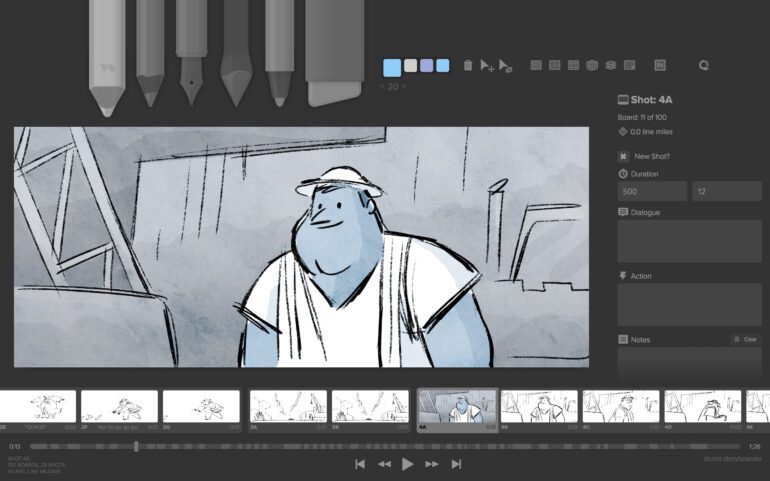TL;DR:
- AI-powered tools aim to replace traditional storyboard artists.
- Storyboarder.ai stands out as a cutting-edge solution for streamlining the storyboarding process.
- Fynal’s cloud-based platform analyzes scripts and generates shortlists, offering personalized adjustments.
- Storyboardhero by Ilathys presents an alternative approach, requiring script creation within the software.
- Co-founder of StoryboardHero shares insights on the transformative potential of AI in video production.
- Storyboardhero offers in-house artists the option to reimagine AI-generated storyboards.
- Generic AI tools like Runway also find their place in storyboarding, showcasing wider adoption.
- AI storyboard tools find more relevance in live-action filmmaking than animation.
- Animation industry may integrate AI technologies to reduce reliance on storyboard artists.
Main AI News:
In a landscape defined by rapid technological advancements, it’s no surprise that AI is setting its sights on creative domains. Enter the world of storyboarding, a critical facet of visual storytelling in both film and animation. This year has witnessed the emergence of a slew of AI-powered tools aiming to replace traditional storyboard artists. One standout among these is Storyboarder.ai – an innovative solution poised to transform the traditionally “laborious and time-consuming” process of storyboarding into a swift and seamless endeavor.
The brainchild of Fynal, a German film production powerhouse nestled in Dortmund and Essen, Storyboarder.ai introduces a paradigm shift. At its core, the platform is driven by a cloud-based infrastructure that harbors the potential to revolutionize the entire storyboarding ecosystem. The mechanism is elegantly simple: users submit their screenplay as a PDF, and the AI-powered software takes it from there. Parsing the script, Storyboarder.ai meticulously assembles a shortlist. Users are then presented with these shot descriptions, allowing for personalized adjustments to be made, such as setting general parameters for each shot. In response, the AI engine generates a series of images – a starting canvas that can be further honed to reflect the desired style and essence.
Competition in this sphere is not to be underestimated, as Singaporean tech trailblazer Ilathys debuts their contender, Storyboardhero. In a departure from Storyboarder.ai’s methodology, Storyboardhero necessitates users to craft their scripts directly within the software. Although seemingly less accommodating than Storyboarder’s automatic analysis of industry-standard scripts, it beckons a shift in how creators approach storyboarding.
Jean-Christophe Bouglé, co-founder of StoryboardHero, underlines the transformative power of AI with a poignant narrative. Having traversed over a decade in the realm of video production through Fewstones, a video agency, Bouglé’s insights resonate profoundly. He elucidates, “We have been creating videos for clients for more than 10 years… It used to take us days to create scripts and storyboards. That’s why we created StoryboardHero, an AI storyboard generator. We have been able to drastically reduce the time needed to create full storyboards for our clients and prospects.”
Storyboardhero’s innovative twist lies in its offer for in-house artists to re-imagine the storyboards, a proposition that prompts contemplation about the software’s intended role. The intersection of artistic human intervention with automated AI creation generates intriguing possibilities.
Expanding beyond dedicated storyboard AI programs, the tide reveals a broader adoption of generic AI tools for storyboarding pursuits. This metamorphosis is encapsulated in a YouTube video, wherein creators elucidate how they leverage the generative AI program Runway to conceive rudimentary storyboards.
As we dissect these developments, it becomes apparent that AI storyboard tools currently resonate more profoundly with live-action filmmakers than their animation counterparts. Animation storyboards inherently demand a deeper level of detail, encompassing elements beyond mere shot composition and framing. However, the horizon beckons a transformation – an era where animation production integrates these nascent technologies, potentially resulting in a leaner roster of storyboard artists dedicated to refining pre-existing AI-generated storyboards.
An undeniable undercurrent underscores these shifts – the accelerated trajectory of technological progress dwarfing the animation industry’s ability to respond. The impending rise of AI as a contender for roles that have endured for a century in animation production is undeniable. Artists and their representative unions stand at a crossroads, tasked with formulating a cogent response to this formidable threat. The narrative they weave must resonate with industry producers, crystalizing why the irreplaceable human touch of board artists remains an imperative that technology cannot replicate.
Conclusion:
The emergence of AI-powered storyboard tools signifies a paradigm shift in creative filmmaking. While their applicability is more prominent in live-action contexts, the animation industry could also embrace these technologies to enhance efficiency. This transformative trend necessitates a proactive response from artists and unions to emphasize the irreplaceable value of human touch in storyboarding, steering the market towards a dynamic future of human-AI collaboration.

